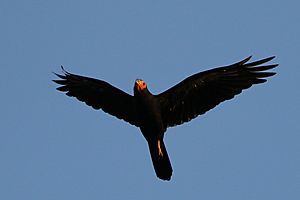Black caracara facts for kids
Quick facts for kids Black caracara |
|
|---|---|
 |
|
| Conservation status | |
| Scientific classification | |
| Genus: |
Daptrius
|
| Species: |
ater
|
 |
|
The black caracara (scientific name: Daptrius ater) is a fascinating bird of prey. It belongs to the Falconidae family, which also includes falcons. You can find these birds in the lowlands of the Amazon rainforest and French Guiana, often near rivers.
People in different places have special names for them. In Republic of Suriname, they are called Ger' futu busikaka. The Emberá people in Panama and Colombia call them juápipi. These names are used for several birds in the Falconidae family. Some also call it the "tapir-hawk" because it's often seen with tapirs.
Black caracaras don't migrate, meaning they stay in the same tropical areas all year round. They are usually seen in small groups of 2 to 5 birds, often resting in tall trees.
Like other caracaras, this bird eats many different things. It's an omnivore, meaning it eats both plants and animals. It hunts, eats dead animals (scavenges), and looks for food.
Contents
About the Black Caracara
What is a Black Caracara?
The black caracara is a type of bird of prey. It's part of the Falconidae family, which includes falcons and other caracaras. This bird is known for its glossy black feathers.
Where Do They Live?
Black caracaras live in South America. You can find them in countries like Bolivia, Brazil, Colombia, Ecuador, French Guiana, Guyana, Peru, Suriname, and Venezuela. They prefer subtropical or tropical moist lowland forests and areas near rivers. They can also live in mangroves and forests that have been changed by humans. They are usually found at altitudes from sea level up to 900 meters.
How Do They Look?
Adult black caracaras are mostly shiny black. They have a clear white band at the base of their tail. Their feet and face are bright yellow to orange-red. They look a bit like their close relative, the red-throated caracara. However, black caracaras have longer, narrower wings and tails. Their beaks are black. Red-throated caracaras have red throats, which helps tell them apart.
An adult black caracara is about 41 to 47 centimeters long. Females are usually bigger, weighing about 350 to 440 grams. Males weigh around 330 grams. Young black caracaras look a bit different. They have dull black feathers and a pale yellow face. They also have 3 to 4 black bars on their tail feathers.
How Do They Fly?
When you see a black caracara flying from far away, you'll notice it flaps its wings a lot. It doesn't usually just glide or soar in the air.
Black Caracara Behavior
Social Life and Habits
Black caracaras are often seen in pairs or small family groups of 3 to 4 birds. Sometimes, you might spot one alone. They fly in straight lines, flapping their wings continuously. They also walk along rivers and perch high up in tall trees.
They are famously seen with large animals like tapirs and capybaras. They pick tiny bugs, called ectoparasites, from the fur of these animals. This is a helpful relationship for both sides. Tapirs even call out to nearby black caracaras and then lie still to help the birds remove ticks.
These birds are also known to look for food near human settlements. They can even catch fish along rivers.
What Do Black Caracaras Eat?
Black caracaras eat almost anything! They are known as "opportunistic feeders." This means they eat whatever food is available. Their diet includes plants, dead animals (carrion), and live prey.
They eat baby birds and young birds that have just left the nest. They also hunt smaller birds like flycatchers and pigeons. Their diet also includes small mammals, frogs, reptiles, insects, and small fish. They even eat palm nuts and other fruits.
To find all this food, they use different hunting methods. They might attack other birds' nests directly. They also search tree leaves with their beaks for insects. They are comfortable scavenging for food in human camps.
How Do They Fish?
Black caracaras are good at fishing in rivers. They use rocks and plants in and around the water. They walk slowly, looking into the water for small fish, like those from the Characidae family. Once they spot a fish, they catch it with their beak or talons (claws). Then they carry it away from the river to eat. They often fish in fast-moving parts of rivers. This is where migrating fish might get stuck among plants or in shallow pools. This shows how they take advantage of easy opportunities to find food.
What Do They Sound Like?
You can recognize a black caracara by its loud, sharp, single kraaaa call. This call usually happens when they are flying. They often repeat the call several times, and it might get quieter towards the end. They don't have many different calls, mostly just variations in how long or loud their distinctive shriek is.
Black Caracara Family Life
Nests and Eggs
Not much is known about how black caracaras reproduce. There is only one record of a nest ever being observed. This nest was found in Brazil. It was built from twigs, about 60–70 centimeters long, and placed very high up in a tree, about 25 meters from the ground. The nest contained 2-3 spotted, brown eggs.
Conservation Status
The IUCN estimates that there are between 1,000 and 10,000 black caracaras in the world. About 670 to 6,700 of these are adults. Their population has decreased a bit over the last 10 years. However, they are not currently considered to be in critical danger. This is because they live across a very large area. They can also survive in forests that are broken up into smaller pieces. Plus, their varied diet helps them find food easily.
See also
 In Spanish: Caracara negro para niños
In Spanish: Caracara negro para niños



